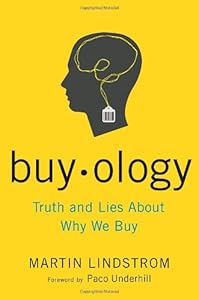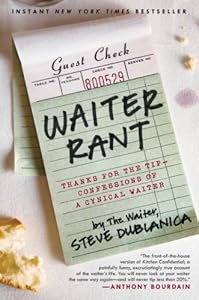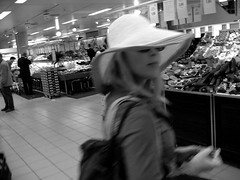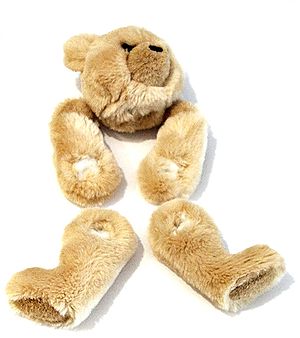The Retail Muse must be hungry this week, as our post is all about food. From local produce to food deserts, to a menu of Pop Tarts and goat meat, we'll cover it all and provide a few inspirational snacks along the way.
Local is In.
Customers are becoming more and more engaged in where their produce is coming from. Grocers have started to respond by adding a greater selection of produce sourced from local farmers. In Indiana for example, Meijer's grocery chain has increased locally sourced produce to 27% of their inventory. A spokesperson sees this as a way to create a fresh new Farmer's Market experience in the store, while at the same time saving costs and cutting out the food wholesaler. Customers are enthusiastic, as it means fresher, locally grown produce, with a lower price point.
Over on the west coast, in California, The Fresh and Easy grocery store chain has created a new program. It's called "Farm to Store in 24 hours". Fresh and Easy have worked with local growers to get produce on the shelf within 24 hours of it being picked. Although their have been challenges working out all of the mechanics for this, customer response has been positive and the chain is seeing big increases in their produce sales.
What struck "The Muse" most about these stories is how a campus store might be able to capitalize on this buy local obsession. Farmers want to deal with local retailers, customers want to buy local products, and the campus store is positioned about as local as you can get. Some imaginative campus retailer should head down to their local farmer's market this weekend and see what opportunities their might be.
Imagine the Campus Farmers Market each week......
Food Deserts
No, not dessert. Deserts. The inner city of large metropolitan areas that are real food deserts. No place to buy fresh produce, no grocery store available until you hit the suburbs. Walgreen's is piloting a program, adding fresh produce, meat and cheese to inner city stores in the Chicago area. The idea is to expand selection, offer healthier alternatives, and reduce the emphasis on packaged foods.
Campus retailers? Well another far out there idea for those stores in urban areas, far from the traditional grocery store offerings. If you operate in an area like this, then it is worth considering as a new revenue stream and expanding your marketplace.
Pop (up) Tarts Store
Joining other candy purveyors like Hershey and M&M's, Pop Tarts have created a pop up store in Times Square, NYC. It's a weird and wonderful creation, including such bizarre things as Pop Tarts sushi, a laser light show that stimulates the look of frosting, and a create your own pop tarts vending machine. The store is more an experience centre, which boasts pop tart video games and pop tart cafe.
We have no idea how this weird pop tart culture center would impact campus retailers, but love the idea of a frosting like light show distracting students in BTC lineups!
And finally, Goats. We just had to mention a recent article that Harrods, the UK luxury department store, is adding goat meat to it's offerings. Presumably goat meat is the next big thing for uber trendy restaurants and foodies, and Harrod's is determined to pick up on the trend.
That's it for this week! YOU are off to check out the farmer's market and to think about food deserts. We here at "The Muse" plan to work on our exclusive goat meat pop tart creation. Ummm goat and frosting!
Monday, August 16, 2010
Friday, August 06, 2010
Back to Campus Shopping Season
Ah the world of back to school (BTS) shopping. In the great big world of retail, BTS is the second biggest cash cow of the year. Retailers pull out all the stops, run major promotional campaigns, and look for ways to weave themselves into the minds and wallets of customers. So, onwards to BTS 2010. A time when Back to School now means "Back to Campus" (BAC). When hauls are the new marketing brainwave, and social networking becomes the new medium for snaring shoppers.
From BTS to BAC
Back to School campaigns have often been focused on the K to 12 marketplace. But, as campus retailers know, there is a huge market in the "Back to Campus" crowd. Mainline retailers are waking up to this fact, inspired by estimates showing that the Campus crowd will spend twice as much (45.8 Billion) than the K to 12 crew (21.4 Billion).
The National Retail Federation (NRF) has a great article on the campus trend, and points out a few interesting facts. They mention that Freshman don't seem to be the buyers this year, suggesting that they may be deferring purchases right now. The upside is a focus on male shoppers. Dads will spend more on their children this year, while Mothers are a little more economically cautious, planning to spend 25% less than their their male counterpoint.
Following this gender study, College guys are another hot buying group this year. And, it's not just electronics they are buying. College guys plan to spend more than ever on personal care, clothing and dorm decor.
Campus retailers can read the full article at the NRF website, and consider how they can hook in to this male campus shopper trend before the big boy retailers do.
I Haul, You Haul, We all Haul.
Retailers seem to have embraced "Hauls" as the next great marketing trend. Hauls are videos of shoppers showing off their finds at the local mall. We talked about this trend a few months back, and it appears to be the latest craze for teenage girls with a web cam. Smelling a great promotional idea, retailers are now actively encouraging and promoting hauls of their products as a BTS promotional campaign. J.C. Penny is using hauls as a major marketing campaign this summer, paying popular "haulers" to raid their stores and post videos of their finds. American Eagle is operating a similar campaign, and fashion retailer Forever 21 is in talks to develop a marketing strategy around hauling.
The big trend this year. Will it last? Experts say right now it's working, but with every trend, as soon as retailers start paying (and manipulating) the hauls, viewer cynicism increases. From the campus retail side, I still think there is some value in pursuing this with interested students. Posting hauls of their finds from the campus stores on YouTube can't do any harm right now. It just might lead to a few new sales.
Social Retail Networking.
Retailers were one of the first to grasp the importance of social networking to drive sales, predominately on Twitter and Facebook. Results have been mixed, and there is a fair bit of consumer push back on too much marketing through social networking sites. Still for this BTS season, retailers are focusing attention on this medium.
Sears and Kmart have created "Campus 2010" on Facebook, allowing incoming freshmen to connect with there new roommates and create their dorm room decor online using Sears and Kmart products. The application and portal is a nifty idea, allowing using to virtually see their dorm room made up, and to create wish lists of products they want for unsuspecting parents.
It's cool technology, a clever idea, and a great way to build brand loyalty. I still think the application falls short, simply because of the Sears and Kmart brand. Why can't Campus retailers look at this as a new marketing strategy? Not for 2010, but for 2011? Imagine partnering with some key merchandise suppliers, grabbing some innovative students to develop the application, and launch in the spring of 2011? Remember, brand loyalty is still high for college bookstores, and incoming freshman are looking for a trusted source.
Happy BTC 2010!
From BTS to BAC
Back to School campaigns have often been focused on the K to 12 marketplace. But, as campus retailers know, there is a huge market in the "Back to Campus" crowd. Mainline retailers are waking up to this fact, inspired by estimates showing that the Campus crowd will spend twice as much (45.8 Billion) than the K to 12 crew (21.4 Billion).
The National Retail Federation (NRF) has a great article on the campus trend, and points out a few interesting facts. They mention that Freshman don't seem to be the buyers this year, suggesting that they may be deferring purchases right now. The upside is a focus on male shoppers. Dads will spend more on their children this year, while Mothers are a little more economically cautious, planning to spend 25% less than their their male counterpoint.
Following this gender study, College guys are another hot buying group this year. And, it's not just electronics they are buying. College guys plan to spend more than ever on personal care, clothing and dorm decor.
Campus retailers can read the full article at the NRF website, and consider how they can hook in to this male campus shopper trend before the big boy retailers do.
I Haul, You Haul, We all Haul.
Retailers seem to have embraced "Hauls" as the next great marketing trend. Hauls are videos of shoppers showing off their finds at the local mall. We talked about this trend a few months back, and it appears to be the latest craze for teenage girls with a web cam. Smelling a great promotional idea, retailers are now actively encouraging and promoting hauls of their products as a BTS promotional campaign. J.C. Penny is using hauls as a major marketing campaign this summer, paying popular "haulers" to raid their stores and post videos of their finds. American Eagle is operating a similar campaign, and fashion retailer Forever 21 is in talks to develop a marketing strategy around hauling.
The big trend this year. Will it last? Experts say right now it's working, but with every trend, as soon as retailers start paying (and manipulating) the hauls, viewer cynicism increases. From the campus retail side, I still think there is some value in pursuing this with interested students. Posting hauls of their finds from the campus stores on YouTube can't do any harm right now. It just might lead to a few new sales.
Social Retail Networking.
Retailers were one of the first to grasp the importance of social networking to drive sales, predominately on Twitter and Facebook. Results have been mixed, and there is a fair bit of consumer push back on too much marketing through social networking sites. Still for this BTS season, retailers are focusing attention on this medium.
Sears and Kmart have created "Campus 2010" on Facebook, allowing incoming freshmen to connect with there new roommates and create their dorm room decor online using Sears and Kmart products. The application and portal is a nifty idea, allowing using to virtually see their dorm room made up, and to create wish lists of products they want for unsuspecting parents.
It's cool technology, a clever idea, and a great way to build brand loyalty. I still think the application falls short, simply because of the Sears and Kmart brand. Why can't Campus retailers look at this as a new marketing strategy? Not for 2010, but for 2011? Imagine partnering with some key merchandise suppliers, grabbing some innovative students to develop the application, and launch in the spring of 2011? Remember, brand loyalty is still high for college bookstores, and incoming freshman are looking for a trusted source.
Happy BTC 2010!
Related articles by Zemanta
- J.C. Penney, others turn to YouTube 'haul' videos for help (usatoday.com)
- Electronics, Dorm Furnishings Focus of Back to College Shopping (shoppingblog.com)
- Teen stores in tight spot for back-to-school (msnbc.msn.com)
Thursday, August 05, 2010
The summer 2010 Retail reading list
Summer is half over. And you are finished working your way through the "girl who" trilogy by that Scandinavian author. Now it's back to business, and breeze your way through a few well written books on creative, retailing and trends.
Here it is.
"The Retail Muse" Summer reading series for 2010:
1. Blink: The Power of Thinking Without Thinking | Malcolm Gladwell
 Gladwell, the author of "The Tipping Point", takes the reader on a journey into the subconscious mind and how we make snap decisions. His treatise is to reveal the difference between good and bad decision making. How, if we focus on a few key details, we make better decisions than if we scan all the vast information available to us.
Gladwell, the author of "The Tipping Point", takes the reader on a journey into the subconscious mind and how we make snap decisions. His treatise is to reveal the difference between good and bad decision making. How, if we focus on a few key details, we make better decisions than if we scan all the vast information available to us.Lots of discussion related to neuroscience and psychology, but don't let that turn you off. Gladwell is an engaging and enthusiastic writer that takes dreary concepts and makes them come to life. Recommended for anyone interested in becoming a better decision maker.
2. What Women Want: The Global Market Turns Female Friendly | Paco Underhill
Paco Underhill has been retailers' guru since the publication of "Why We Buy". Now Underhill turns his sites from the shopping aisles and considers the aspect of gender in the shopping and buying process. Paco asserts that females are now new power consumer in retail, and it is the influence of women that is reshaping the commercial landscape.
Peppered with his usual charming but soft touch sense of humor, Underhill goes on a mission with us to understand the difference between female and male shoppers. Every retailer should be reading this book to understand he difference between the sexes in the shopping aisles.
3. Buyology: Truth and Lies About Why We Buy | Gary Singer
 Retailing and neuroscience is the new black. Singer goes into a great deal of detail (and a few brain scans or two) to show us how neuroscience and brain activity play an immense role on our purchasing decisions, from toothpaste to T-birds. Unless one of your hobbies is reading neuroscience textbooks, this one is not for the faint of heart. Still, some of the chapters on consumer behavior, along with discussions on how advertising and marketing agencies use neuroscience to drive purchasing, are well worth checking out.
Retailing and neuroscience is the new black. Singer goes into a great deal of detail (and a few brain scans or two) to show us how neuroscience and brain activity play an immense role on our purchasing decisions, from toothpaste to T-birds. Unless one of your hobbies is reading neuroscience textbooks, this one is not for the faint of heart. Still, some of the chapters on consumer behavior, along with discussions on how advertising and marketing agencies use neuroscience to drive purchasing, are well worth checking out.4. Waiter Rant | Steve Dublanica -AND - Waiting: The True Confessions of a Waitress | Debra Ginsberg
 Alright. So not exactly about retail, but any tale from the restaurant trenches make a retailer feel like they are living the lap of luxury. Both books are similar formats. Not planning to become restaurant servers through a series of coincidences, living to tell the tale. Both share the terrible customer stories, the poor working conditions and management that have gone out of control.
Alright. So not exactly about retail, but any tale from the restaurant trenches make a retailer feel like they are living the lap of luxury. Both books are similar formats. Not planning to become restaurant servers through a series of coincidences, living to tell the tale. Both share the terrible customer stories, the poor working conditions and management that have gone out of control.Highly recommended for their fun and breezy style, and the anecdotes that they offer. Perfect beach reads before you head back to the store for back to college rush.
Related articles by Zemanta
- Paco Underhill on what women want to buy. (slate.com)
- Shopping Scientist Paco Underhill Tackles Online Retail (blogs.wsj.com)
- The Frontal Cortex blog: The next Malcolm Gladwell? (ksjtracker.mit.edu)
The re-usable shoplifting bag
 Image by wili_hybrid via Flickr
Image by wili_hybrid via FlickrAll well and good. But now comes reports that re-usable tote bags are causing an increase in shoplifting. One national grocery store chain has raised the concern with head office. With customers increasingly shopping the grocery aisles with their tote bags in hand, it's become easy to slip a few items in the tote and leave without paying. In other cases, shoplifters are filling their bags with high end items, paying only for a portion of their selections.
Retailers are especially vulnerable to the shoplifting tote bag when coupled with self checkout systems. Difficult to keep an eye on both the customers with tote bags and the self checkout lanes.
Loss Prevention Specialists note that re-usable tote bags lined with tinfoil are on the rise. Professional shoplifters use these bags to nab expensive items, while the tinfoil lining allows the merchandise to clear alarm systems.
So far the national chains are not asking customers to leave their tote bags at the front door. Instead they are focusing on staff training to keep an eye out for these re-usable tote bandits.
Related articles by Zemanta
- Is Your Re-Usable Bag Trying To Kill You ? (themoderatevoice.com)
- San Francisco plastic bag ban could extend to all city retailers (marketplace.publicradio.org)
Wednesday, August 04, 2010
Retail is Hard
Image via Wikipedia
For years I've heard from many that working in retail is a breeze. Everyone has an opinion on how easy it would be to work at the cash register all day, or has these romantic notions of how much fun it would be to own a little shop by the seaside. Customers also seem to have a wide range of advice of how to staff your store. What products to carry (and how many), and of course what your operating hours, pricing strategy and marketing programs should be. Everyone is an expert, especially when it comes to retailing.
I was reminded of this curious state of being recently. I was watching the UK version of "The Apprentice" on "YouTube". This British version, (now in it's 6Th season) is basically the original "Apprentice", sans Donald Trump and the addition of sometimes difficult to interpret accents.
The show follows the same format, with each team of apprentices sent out on weekly tasks to make money. In one episode, the teams are sent off to Harrods, billed as the largest department store in the world (7 floors! Luxury goods! something for everyone!). Teams were given the task of choosing items from Harrod's inventory and then sell them to unwitting tourists in special pop up units within the vast store.
Watching the teams perform this task made me realize how incredibly clueless this group of bankers and lawyers and entrepreneurs where about the mechanics of retail. One team learned that it is very difficult to choose products for resale. They settled on teddy bears - nothing else, including a $2000 mega stuffed bear. A dubious and ill advised choice. Then other team added more variety, but learned that merchandising products is not just about hanging one sad t-shirt on slat wall.
Both teams found pricing hard to figure out. All these accountants and business majors couldn't figure out the difference between cost and retail. They were lost on the concept of retail margin, and stared glumly at the point of sale equipment wondering what all the flashing lights meant.
By the time they started to actually operate their store, I was in heavy eye-rolling mode. One team member shrunk into the the woodwork, fearful of chatting with strangers. Another became panicked and aggressive, almost demanding frightened customers to buy a bear. Finally a team member couldn't take the pace any longer, snuck away to the stock room. As he rubbed his aching feet and moaned about how he has never spent this much time on his feet, he looked at the camera and said;
Retail is Hard!
Yes dear apprentice, sometimes it is.
Subscribe to:
Comments (Atom)






